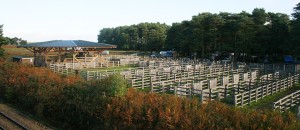B – A-Z of Commoning and the New Forest
Browsing line
Most of the deciduous trees in the open Forest are bare of leaves and twigs below a line about two metres from the ground, because the browsing ponies, deer and cattle keep them stripped. The browsing line is a very noticeable feature of the Forest.
Bottom
Bottom is an old word for a valley floor. There are several strangely named bottoms in the New Forest, including Dead Man’s Bottom and even Slap Bottom!
Boiling mounds
Boiling mounds are ancient piles of flint that have been heated by fire. The mounds are found near sources of water, sometimes next to shallow hollows in the ground. The theory is that they were used by our ancestors to boil water. The flints would have been put in a fire until they were very hot, then dropped into the water in the hollow. Boiling mounds are common across the Forest.
Byelaws
Bylaws are rules about what can and can’t be done in the Forest. Forestry England and the National Trust each have byelaws for the parts of the Forest they own or manage.
The Verderer’s byelaws apply across the Forest, and are mainly about commoning- for example, there’s a rule that ponies living out on the Forest can’t be shod. The bylaws are there to protect the Forest, so get to know them. You can download the Verderers’ byelaws here.
Beaulieu Road
Beaulieu Road is where ponies are bought and sold at a special sales yard near Beaulieu  Road railway station. The link to the railway is from the days when ponies were sold all over the country, with some going to work in coal mines.
Road railway station. The link to the railway is from the days when ponies were sold all over the country, with some going to work in coal mines.
The ponies are kept in wooden pens then taken to be shown in a sales ring. There are just a few sales every year. The dates are published by the New Forest Livestock Society.
The New Forest Trust holds the lease for the sales ground, and helps to cover the cost of the sales by paying the rent and insurance.

